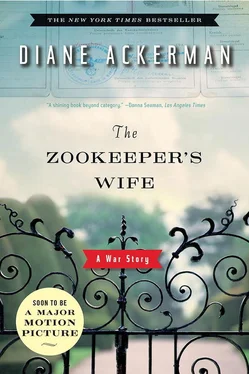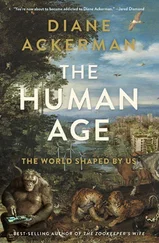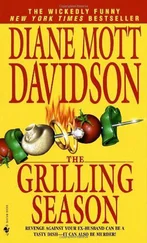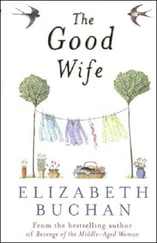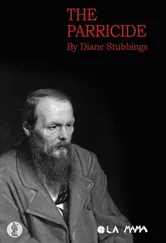The following day, to their surprise, the guard returned and said that Heck planned a visit soon, and when the guard left they wondered what to do. They didn’t trust Heck, but on the other hand, he was sweet on Antonina, and in theory, as a fellow zookeeper, he should be sympathetic to their situation. In an occupied country where survival often depended on having friends in high places, cultivating Heck made sense. Antonina thought Heck relished the idea of being her patron, a medieval knight like Parsifal, some romantic ideal to win her heart and prove his nobility. As she wondered if his overture signaled help or harm, her mind filled with feline battery: “For all we know he may just be playing with us. Big cats need little mice to toy with.”
Jan made a case for Heck’s possible goodwill: as a zookeeper himself, Heck loved animals, spent his life protecting them, and undoubtedly sympathized with fellow zookeepers’ losses. And so, poised between hope and fear, they passed the night before Lutz Heck’s first visit.
After curfew, Poles could no longer stroll under a canopy of stars. They could still watch August’s Perseids, followed by the autumn meteor showers—the Draconids, Orionids, and Leonids—from their windows and balconies, but thanks to all the shelling and dust, most days became cloudy with tumultuous sunsets and a drizzle before dawn. Ironically, the far-ranging warfare that created grotesque battlefields and pollution also inspired gorgeous sky effects. Now, fast-falling meteors at night, however kitelike their tails, conjured up images of gunfire and bombs. Once meteors had figured in a category of mind remote from anything technological, as wayfarers from distant realms where stars sparkled like ice-coated barbed wire. Long ago, the Catholic Church had christened the Perseids the tears of Saint Lawrence because they occurred near his feast day, but the more scientific image of dirty snowballs pulled by invisible waves from the rim of the solar system, then yanked down to earth, evokes its own saintly magic.
LUTZ HECK TOOK OVER THE BERLIN ZOO FROM HIS DISTINGUISHED father in 1931, and almost immediately began remodeling the zoo’s ecology and ideology. To coincide with the 1936 Olympics, held in Berlin, he opened a “German Zoo,” an exhibit honoring the country’s wildlife, complete with “Wolf Rock” at its center, surrounded by enclosures for bears, lynxes, otters, and other native species. This bold patriotic display underscoring the importance of familiar animals, and that one needn’t go to the ends of the earth to find exotic species, conveyed a laudable message, and if he’d unveiled his exhibit today, his motives wouldn’t be questioned. But given the era, his beliefs, and the ultranationalism of his family, he clearly wanted to please Nazi friends by contributing to the ideal of Germany’s master races. A 1936 photograph shows Heck and Göring on a hunting trip to Schorfheide, Heck’s large preserve in Prussia; and the following year, Heck joined the Nazi Party.
A big-game hunter, Heck spent the peak moments of his life pursuing danger and adventure, several times a year launching trips to garner animals for his zoo and perhaps bag a pair of longhorn sheep heads for his wall or come face to face with a toweringly mad female grizzly. He relished wild razor-edged hunts, in Africa especially, which he recapped in scenic letters, written by lantern light, astride a camp stool near a well-fed fire, while lions grunted invisibly in the blackness and his companions slept. “The campfire flickering in front of me,” he once wrote, “and behind me coming out of the dark infinity the sounds of an invisible and mysterious wild animal.” [16] Lutz Heck, Animals—My Adventure , trans. E. W. Dickies (London: Methuen, 1954), p. 60.
Alone yet faintly haunted by circling predators, he would replay the day’s exploits in ink, some to save, some to share with friends in another drape of reality, the Europe that seemed to him planets away. Action photographs often accompanied his letters: lassoing a giraffe, leading a baby rhinoceros, capturing an aardvark, evading a charging elephant.
Heck loved collecting trophies, as memory aids to a wild part of his self that emerged in remote wilderness—live animals to display at his zoo, dead animals to stuff, photographs to share and frame. In the heyday of his travels he seemed to collect life itself, keeping voluminous diaries, snapping hundreds of photographs, and writing popular books (such as Animals—My Adventure) which limned his passion for the wilderness, in which he detailed feats of extraordinary bravery, stoicism, and skill. Heck knew his strengths, admired the heroic in himself and others, and could tell a bar-gripping story over drinks at annual meetings. Though he indulged in self-mythology from time to time, his personality fit a profession which has always attracted some people with a yen for exploration, in flight from domesticity, and craving just enough ordeal to feel the threads of mortality fraying. Without his type, maps would still show a flat earth and no one would believe the source of the Nile. Sometimes Heck slayed dragons—or rather their real-life equivalents—but mainly he captured, photographed, and displayed them with gusto. Passionate and single-minded, when he set his sights on an animal, either in the wild or belonging to someone, he lusted after it, tried every lure or ruse he could think of, and persisted until he exhausted the animal or wore down its owner.
For decades the Heck brothers had pursued a fantastic goal, a quest that engaged Heinz but completely infatuated Lutz: the resurrection of three pure-blooded, extinct species—the Neolithic horses known as forest tarpans, aurochsen (the wild cow progenitor of all European cattle breeds), and the European or “forest” bison. On the eve of the war the Hecks had produced some near aurochsen and tarpans of their own, but the Polish strains ran truer to type, the clear inheritors.
Only prehistoric creatures would do, ones untainted by racial mixing, and although Lutz hoped to gain influence and fame in the process, his motives were more personal—he sought the thrill of bringing extinct, nearly magical animals back to life and steering their fate, hunting some for sport. Genetic engineering wouldn’t emerge until the 1970s, but he decided to use eugenics, a traditional method of breeding animals which showed specific traits. Heck’s reasoning went like this: an animal inherits 50 percent of its genes from each parent, and even an extinct animal’s genes remain in the living gene pool, so if he concentrated the genes by breeding together animals that most resembled an extinct one, in time he would arrive at their purebred ancestor. The war gave him the excuse to loot east European zoos and wilds for the best specimens.
As it happens, the animals he chose all thrived in Poland, their historic landscape was Białowieża, and the imprimatur of a respected Polish zoo would legitimize his efforts. When Germany invaded Poland, Heck scouted the farms for mares preserving the most tarpan traits to mate them with several wild strains, including Shetlands, Arabians, and Przywalskis, hoping to breed back to the ideal animal, the fierce, nearly unridable horses painted in ochre on Cro-Magnon caves. Heck assumed it wouldn’t take many generations of back-breeding—maybe only six or eight—because as recently as the 1700s tarpans still roamed the forests of northeastern Poland.
During the Ice Ages, when glaciers blanketed northern Europe and a wind-ripped tundra stretched down to the Mediterranean countryside, thick forests and fertile meadows gave refuge to great herds of tarpans that roamed the central European lowlands, browsed the east European steppes, and galloped across Asia and the Americas. In the fifth century B.C., Herodotus said how much he enjoyed watching herds of tarpans grazing in the bogs and marshes of what is now Poland. For ages, purebred tarpans outwitted all the hunters and somehow survived in Europe, but by the eighteenth century not many remained, in part because diners prized tarpan meat—it was sweet, but more appealingly, it was rare—and in part because most tarpans had interbred with farm horses to produce fertile offspring. In 1880, pursued by humans, the last wild tarpan mare fell down a crevasse in Ukraine and died; and the last captive tarpan died seven years later in the Munich Zoo. At that point the species officially became extinct, just one more chapter in the annals of life on Earth.
Читать дальше
